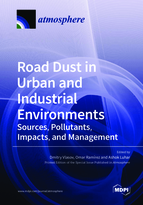Road Dust in Urban and Industrial Environments: Sources, Pollutants, Impacts, and Management
A special issue of Atmosphere (ISSN 2073-4433). This special issue belongs to the section "Air Quality".
Deadline for manuscript submissions: closed (19 November 2021) | Viewed by 53203
Special Issue Editors
Interests: air pollution; road dust; snow cover; precipitation; potentially toxic elements; benzo(a)pyrene; partitioning; urban environment; soils; source apportionment
Special Issues, Collections and Topics in MDPI journals
Interests: air quality; particulate matter; road dust; source apportionment; atmospheric geochemistry
Special Issues, Collections and Topics in MDPI journals
Interests: modelling air pollution meteorology and transport; climate-chemistry interactions and earth system modelling; inverse techniques to determine sources; urban morphology and air quality; Lagrangian dispersion modelling
Special Issue Information
Dear Colleagues,
Resuspended road dust, enriched with potentially toxic elements, polycyclic aromatic hydrocarbons, black carbon, etc., is one of the most important sources of coarse, fine, and ultrafine particles in the atmosphere, which is especially true for industrial sites and cities with a high density of road network and large areas sealed under road pavements. In turn, the chemical composition of road dust is determined by the impact of a wide range of anthropogenic sources, as well as by the deflation of roadside soils in summer and deicing agents in winter, the deposition of suspended atmospheric particles, and precipitation. The chemical and physical characterization of road dust size fractions is a key issue in the understanding of the relationships between several urban and industrial environments and in the identification of pollution sources. However, in many cities and towns, there is a significant lack of knowledge of the composition of road dust and its individual size fractions, dust loadings, and the effect of the anthropogenic impact intensity on the degree of road dust pollution, as well as its potential risks to public health and ecosystems.
We invite authors to submit original and review articles that describe field, experimental, and modelling studies related to detailed analyses of road dust and its various size fractions as a major source of air pollution. Priority attention will be paid to modern techniques, approaches, and methods for assessing the contribution of various sources to the chemical composition of road dust size fractions (source apportionment) and the assessment of public health and ecological risks, as well as other related issues of air pollution by particulate matter, including nanoparticles and microplastics.
Dr. Dmitry Vlasov
Dr. Omar Ramírez
Dr. Ashok Luhar
Guest Editors
Manuscript Submission Information
Manuscripts should be submitted online at www.mdpi.com by registering and logging in to this website. Once you are registered, click here to go to the submission form. Manuscripts can be submitted until the deadline. All submissions that pass pre-check are peer-reviewed. Accepted papers will be published continuously in the journal (as soon as accepted) and will be listed together on the special issue website. Research articles, review articles as well as short communications are invited. For planned papers, a title and short abstract (about 100 words) can be sent to the Editorial Office for announcement on this website.
Submitted manuscripts should not have been published previously, nor be under consideration for publication elsewhere (except conference proceedings papers). All manuscripts are thoroughly refereed through a single-blind peer-review process. A guide for authors and other relevant information for submission of manuscripts is available on the Instructions for Authors page. Atmosphere is an international peer-reviewed open access monthly journal published by MDPI.
Please visit the Instructions for Authors page before submitting a manuscript. The Article Processing Charge (APC) for publication in this open access journal is 2400 CHF (Swiss Francs). Submitted papers should be well formatted and use good English. Authors may use MDPI's English editing service prior to publication or during author revisions.
Keywords
- air pollution
- road dust and road pavement
- particle size distribution
- source apportionment
- environmental interactions
- toxic elements and compounds
- nanoparticles and microplastic
- spatial variation and modelling
- health and ecological risks
- mitigation strategies








